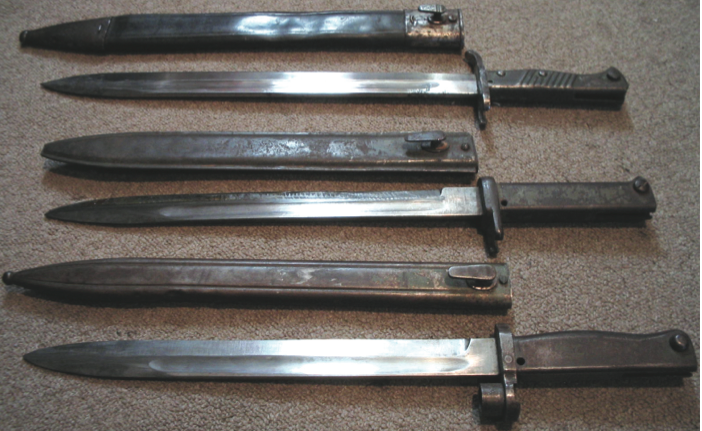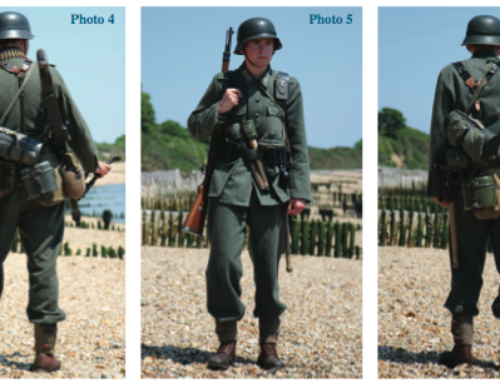When I started collecting militaria and weaponry, I was originally drawn to bladed weapons. However, as a teenager and then a student, I could not afford the prices of some of the swords I would have loved to buy. In bayo nets I found a cheaper option to satisfy my interest in bladed weapons. They were plentiful, as you could find bayonets in most flea-markets and antique or junkshops, and the price was usually reasonable.
When starting a collection the first impulse is to buy everything you see, of every type you find. After this initial burst of spending, you will find that you have a core collection of bayonets. There is no right or wrong way to collect bayonets, however, trying to buy everything will cost a lot of money and take up quite a bit of space too. A suggestion would be to limit your collecting energy to either one coun- try, a historical period or war, a particular manufacturer, or a type of bayonet. I have concentrated on German Mauser bayonets, manufactured for the German market, though at times it has been hard to keep to that and I have ended up purchasing for- eign contract bayonets made for countries that used Mauser rifles, like Argentina, Turkey, Siam, Portugal, etc.
You can collect anything from the ear- liest Plug Bayonets through socket bayonets to sword bayonets. Even modern day bayonets have multiple varieties and mod- els that will keep a collector entertained for a long time, searching for and cataloguing his finds.
As I collected, I realised that I needed information on the bayonets I was looking for. So I began searching for specialist books, and bought several of them. In these volumes I found information on the weapon’s design, the manufacturers, and also the various markings that often appear on bayonets. In the case of British Bayonets the markings tell you where it was manufactured, and which regiment it was issued to or if it was withdrawn from service and sold abroad. These often cryp- tic markings have their own little story to tell and add to the mystery of the bayonet. It makes us think “if only it could talk… what tales would it tell me?” There is also information to be found on the internet nowadays. This is becoming a useful tool, with collectors’ forums where you can exchange information and query items you may have in your collection that you have been unable to identify.
As regards the care of the weapon, there are several views on what should or should not be done. Please note that this is my own personal view and should not be taken as gospel. Before you consider any major cleaning, repair work or restoration work, I suggest you read up on the subject or talk to a reputable dealer or a collector, these people are usually happy to help you with their advice and experience.
When it comes to antiques, the eternal question appears whether to clean or not to clean. It is worth remembering that over enthusiastic cleaning can cause more harm than good. Over polishing, scrubbing, or grinding down metal, can erase markings, etchings and other decoration the blade may have. There is also the patina of age that the bayonet will have acquired over the years it has spent in storage. In my opinion, the idea of the collection is to preserve the item, prevent- ing rust eating up the metal, and damage to the wood and leather, rather than returning the weapon to its original condition.
Careful cleaning with an oiled cloth will remove basic dirt and give the blade a light oily protective coat. Try to avoid leaving fin- ger marks on the blade, as these have a ten- dency to leave a blemish or even start the rust- ing process on the steel. If there is some sur- face rust I use some very fine wire wool that removes the rust marks easily. If the rust is rather more advanced, then a heavier wire wool would be required. However, great care must be taken if the blade has etching, blueing, and patina, as it may be damaged beyond repair.
For general maintenance, I find that wip- ing the dust off once a month keeps the bayo- nets in good condition. Use oil to keep rust at bay, try to avoid abrasive or chemical metal polishes as these again tend to remove any age patina and make the weapon look shiny and garish. The wooden grips can be treated with beeswax furniture polish, and the leather scab- bards with the appropriate leather products to keep the leather from drying out and cracking.
The displaying of the collection can be done in various ways, from hanging them on the walls to displaying them in cabinets. Some collectors eventually start to wonder what their bayonets would look like attached to the weapon they were designed for. In these cases, temptation may lead you to start pur- chasing the rifles and your original bayonet collection will evolve into a different area, and you may become an antique firearms collector. But that is another story.
Article by Ronald Brighouse : from Skirmish Magazine Issue 48







